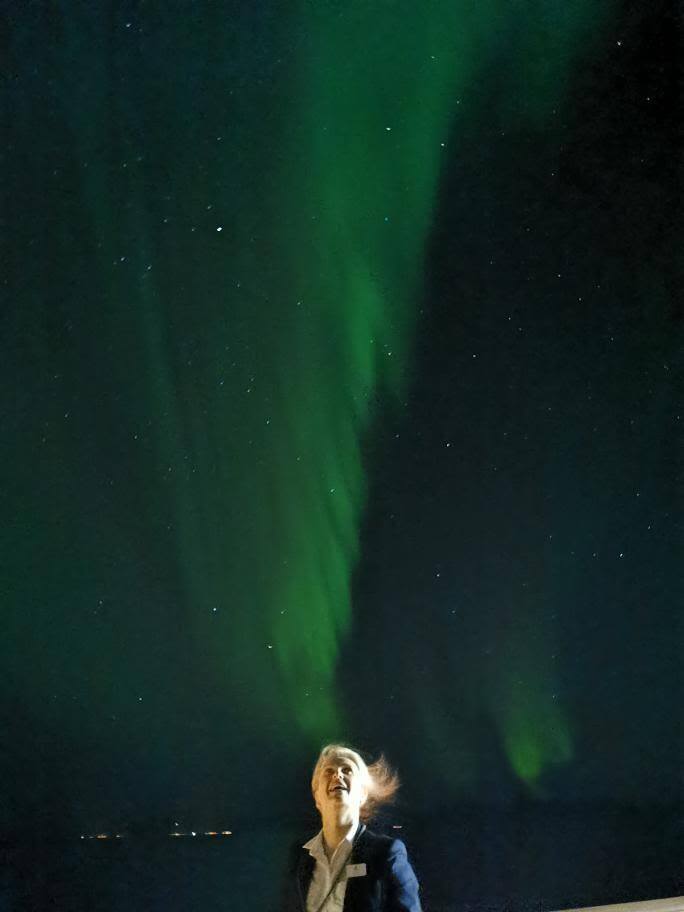Solar Activity Exceeding Predicitons
Will Produce More Northern Lights!
Photo shot from the deck of Havila Castor. Credit: Kari Moe Sundli
According to NASA, Solar Activity is increasing and will continue to do so until it reaches peak levels in 2025. That bodes well for the northern lights.
When Galileo Galilei pointed his telescope towards space in the early 17th century, he discovered some dark spots on the sun. These dark areas are called "sunspots", and they are dark because they are almost 2,000 degrees Celsius colder than the surrounding gasses which are controlled by a very strong magnetic field.
The number of sunspots – and thus the sun's activity level – varies greatly.
“Sunspot activity runs in cycles of an average of 11 years”, says Anne Bruvold, the resident astronomer at the Northern Norwegian science centre in Tromsø (Vitensenteret).
The current solar cycle, which is the 25th on the row since measurements were started in 1755, began in December 2019. Then, sunspot activity was low, but according to NASA the level has increased rapidly and is already much higher than predicted.
In a blog post from NASA, we can read that:
“Solar events will continue to increase as we near solar maximum in 2025, and our lives and technology on Earth, as well as satellites and astronauts in space, will be impacted”.
This is not particularly positive for the satellites, as powerful solar flares can damage them, but for everyone who’s appreciating the northern lights, this is very good news.
Auroras Are Caused by Solar Wind
“Northern lights are caused by a wind made from electrical charged particles, flaring from the sun, and colliding with the earth’s atmosphere. We call this flare solar wind”, Anne Bruvold explains.

Residence astronomer Anne Bruvold at the science center in Tromsø (Vitensenteret).
The more active the sun is, the more particles are being ejected into the Earth's atmosphere, and the more auroras we get.
“When the electrically charged particles from the sun hit the particles in the Earth's magnetic field, they are deflected, and flow down towards the Earth where they hit the Earth's atmosphere in two ovals – one around each of the magnetic poles. Where the solar wind hits the Earth's atmosphere, the atmosphere emits light in specific colours. The strength of the sunlight is determined by how strong the solar wind is”, says Bruvold.
While the ship is docking in Tromsø on Havila Voyages' northbound journey, you can visit the science center and the Northern Lights planetarium.
Northern Lights Come in Several Colours
As the resident astronomer at Vitensenteret lives in Tromsø, she is quite spoiled with auroras, and it’s not as if she’s running outside to stare at the night sky every time the natural neon colours appear.
“But seeing the sky full of northern lights when there is a lot of activity is awesome. What I like best of all is when I get to see a pink-purple colour at the very bottom, underneath all the green. This only occurs when the northern lights are strong, says Bruvold.
“Once, I even saw red northern lights, which are not easy to spot”.
What colours we see on the night sky are determined by what kind of gases the solar wind collides with in the Earth’s atmosphere. If you are lucky, you may occasionally spot yellow, blue, or purple northern lights.
Northern Lights Promise
Do you want to experience the northern lights from one of Havila Voyages’ new coastal cruises ships this autumn or winter? From October 1st to March 31st, we promise that you will witness the northern lights on the Bergen-Kirkenes-Bergen round trip. That means that if the spectacular green light does not dance across the night sky during your Round Voyage within the aforementioned period, you will get a new six- or seven-day voyage from Bergen to Kirkenes (Voyage North) or vice versa (Voyage South) completely free of charge.

From October 1st to March 31st, we promise that you will witness the Northern Lights on the Bergen-Kirkenes-Bergen round trip. Photo: @mitnor (Mireille)
